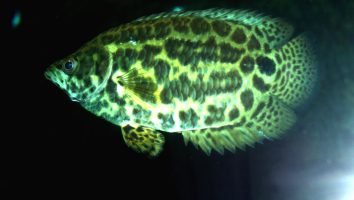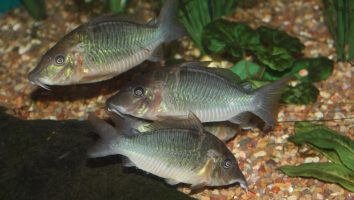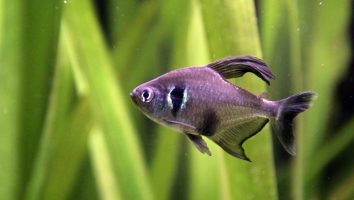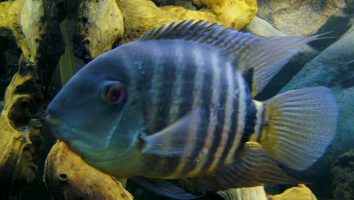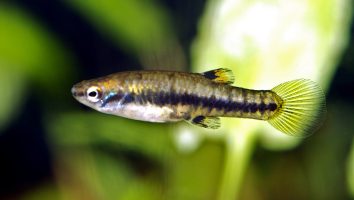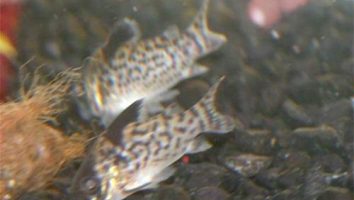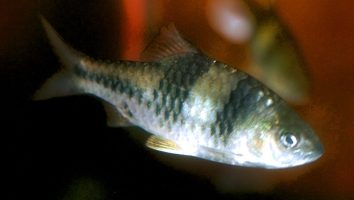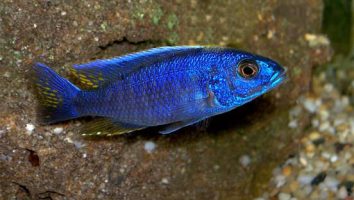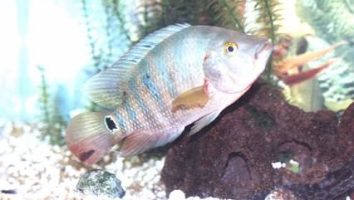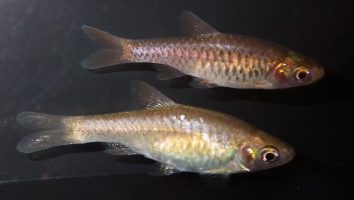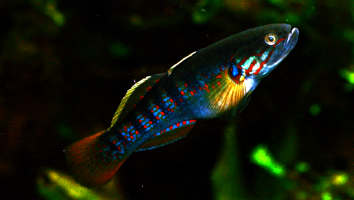The brook stickleback is a small but mighty freshwater fish that is perfect for beginner aquarists.
This species is hardy, adaptable, and easy to care for, making them a great choice for those just starting out in the fishkeeping hobby.
But even though they’re easy to care for, there are still some things you need to know to ensure your fish are happy and healthy.
In this guide, we’ll teach you everything you need to know about brook stickleback care. From diet and tank size, to lifespan and breeding.
Table of contents
Species overview
The brook stickleback (Culaea inconstans) is a small freshwater fish that’s found in North America. They’re most commonly seen in the eastern parts of the continent, particularly in the Great Lakes region and the Hudson Bay drainage basin.
Brook sticklebacks prefer slow-moving water with a lot of vegetation. This could be in the form of a river, stream, or even a lake.
One of the most notable things about the brook stickleback is its diet. These fish are known to eat a wide variety of things, including other small fish, insects, and crustaceans.
Due to their wide diet and their adaptability to different environments, brook sticklebacks are a very popular choice for aquariums. They’re also a popular choice for scientific study, as they’re often used in research on the effects of different pollutants on freshwater ecosystems.
Appearance

The brook stickleback is a small freshwater fish that has a dark olive-green back and a white belly. The males of this species are usually more brightly colored than the females and have a red throat.
The brook stickleback has a long and slender body with a small mouth. They have two dorsal fins, the first of which is much smaller than the second. The brook stickleback also has a forked tail.
Lifespan
The average lifespan of a brook stickleback is 2 to 3 years.
These fish have a relatively short lifespan, but that doesn’t mean they can’t be kept successfully in captivity.
Good water quality and a healthy diet are important for all fish, but it’s especially important for those with a shorter lifespan. That’s because they don’t have as much time to recover from any setbacks.
Size
Brook sticklebacks only grow to be about 2-3 inches long.
Tank
Tank Size
The recommended minimum tank size for Brook sticklebacks is 10 gallons.
Water Parameters
The brook stickleback (Culaea inconstans) is a freshwater fish that is endemic to North America. It is found in streams and rivers with cool, clean water and a gravel bottom.
The brook stickleback is a small fish, reaching a maximum length of about 4 cm (1.6 in). The body is compressed and elongated, with a small head and a large mouth. The back and sides are olive-green to brown, with a dark stripe along the sides. The belly is white.
The brook stickleback is a hardy fish that can tolerate a wide range of water conditions. However, it is best to maintain the following water parameters:
- Water temperature: 50 to 70 degrees Fahrenheit
- pH levels: 6.0 to 7.5
- Water hardness: 2 to 12 dGH
- Alkalinity Levels: 4-8 dKH
What To Put In Their Tank
Brook sticklebacks are a species of freshwater fish that are found in North America. They’re known to inhabit streams, rivers, and lakes.
In the wild, these fish are used to having a lot of space to swim around in. They’re not a species that spends a lot of time hiding so you won’t need to worry about including a ton of decorations in their tank.
A few pieces of driftwood or some rocks should be plenty. As for plants, you can use whatever you want. Just make sure they’re not too big or they might get in the way of these little fish.
The substrate you choose for their tank is up to you. Gravel is always a good choice, but sand can be used as well.
Common Diseases
While the Brook stickleback is a hardy fish, there are still a few diseases that it can fall victim to. The most common seem to be parasites and bacterial infections.
One of the most common parasites is ich. This is a very contagious disease that can quickly spread throughout your tank. The most obvious symptom is the presence of white spots on the body of your fish.
If you notice this, it’s important to take action immediately. There are a variety of ich treatments available, but the sooner you start the better.
Another common disease is bacterial gill disease. This is a fairly serious illness that can be fatal if left untreated. The most obvious symptom is difficulty breathing.
If you notice your fish gasping for air at the surface of the water, this is a cause for concern. Bacterial gill disease is usually the result of poor water quality, so the first step is to improve the conditions in your tank.
If you notice any other symptoms that seem out of the ordinary, it’s always best to consult a vet. They will be able to give you a definitive diagnosis and recommend a course of treatment.
Behavior & Temperament
The brook stickleback is a small, peaceful fish that is native to North America. It is a bottom-dweller that spends most of its time scavenging for food.
The brook stickleback is a shy fish that does best in a tank with other peaceful fish. It is not an aggressive fish and does not have any special care requirements.
Tank Mates
When it comes to brook stickleback tank mates, you have a few different options. In the wild, these fish are found in freshwater streams and ponds.
They’re not fussy when it comes to water conditions, so you can keep them in a wide range of setups.
The same goes for their tank mates. You can mix and match different species to create a community tank that suits your fancy.
Here are some compatible fish to get you started:
- Guppies
- Platies
- Mollies
- Swordtails
- Endler’s Livebearers
- Cherry Barbs
- Pygmy Corydoras
- Dwarf Gouramis
- Neon Tetras
- Harlequin Rasboras
Breeding
The brook stickleback fish is a great choice for beginner fish breeders. They’re easy to care for and their breeding process is relatively simple.
The first thing you need to do is set up a breeding tank. It should be at least 10 gallons and have a few hiding places. Then, you need to adjust the water conditions.
Sticklebacks prefer cool water, so aim for a temperature between 60 and 70 degrees Fahrenheit. They also like water that’s on the acidic side, so aim for a pH of 6.5.
Now you need to add your fish. Sticklebacks are social creatures, so you should add at least six of them to the breeding tank. It’s best to have an even ratio of males to females.
Once the fish are in the tank, you need to give them time to adjust. After a few days, you should start to see the males build nests out of plant material and rocks.
When the females are ready to lay their eggs, they’ll enter the nests and the males will fertilize them. After that, the males will stay and guard the eggs until they hatch.
Once the fry have hatched, you can remove the adults and start feeding them baby brine shrimp.
Conclusion
The Brook Stickleback is a great fish for beginner aquarists. They’re easy to care for and don’t require a lot of special attention.
They’re also a lot of fun to watch as they interact with the other fish in your tank.
If you’re looking for a fish that’s low-maintenance and fun to watch, the Brook Stickleback is a great choice!

